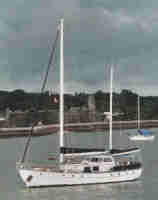|
|
|
HOW TO MARK READABLE DEPTH MARKS ON AN ANCHOR CHAIN.
By Andina Foster, tech@yandina.com.
 This project describes a chain marking system where each mark indicates the length of chain you have out without having to keep count, where you don't need a look up table, only uses 3 colors, and is very easy to memorize. This project describes a chain marking system where each mark indicates the length of chain you have out without having to keep count, where you don't need a look up table, only uses 3 colors, and is very easy to memorize.
Here is the numbering sequence you have to remember
RED = 1, WHITE = 2, BLUE = 3.
There is one other color you have to consider which represents the digit ZERO and that is no color at all. You also have to remember that the markings are placed every 25 feet. |
Each marking on the chain is a combination of only two colors, a background 6 feet long, and a band of color centered on the background that is 2 feet long. This way it is symmetrical and you don't have to know which order they come in.
The LONG background color is the MOST SIGNIFICANT DIGIT, the SHORT color band in the middle is the LEAST SIGNIFICANT DIGIT. So a blue band on a white background would be the number 23. A blank (no color) band in the middle of a red background would be the number 10.
The MOST SIGNIFICANT DIGIT (background color) represents the number of HUNDREDS OF FEET.
The LEAST SIGNIFICANT DIGIT (band color) represents the number of 25 foot SEGMENTS that are out.
So the first example - 

 blue band on white background = digits 2 3 or 200 feet plus 3x25 = 275 feet.
blue band on white background = digits 2 3 or 200 feet plus 3x25 = 275 feet.
The second example - 

 blank band in a red background = digits 1 0 or 100 feet plus 0x25 = 100 feet.
blank band in a red background = digits 1 0 or 100 feet plus 0x25 = 100 feet.
So here are some more examples:-
175 feet 


250 feet 

 Note the band is the same color as the background.
Note the band is the same color as the background.
25 feet 

 Note the background is zero or no color, just a 2 foot band.
Note the background is zero or no color, just a 2 foot band.
So the very first mark at the point where the chain meets the anchor is zero hundreds and zero X 25 so no band on no background which looks like:-

 OK?
OK?
The maximum length this scheme will go to is 375 feet or 

 .
.
If you need longer than 375 feet, I guess you could start over with the minor disadvantage that the 400 foot marker would be missing since it is a blank band on a blank background.
HOW TO PAINT THE CHAIN
If it is new, galvanized chain, check with your paint store for a suitable primer otherwise it is going to come off quite quickly. Even an older chain will probably work better with a primer for galvanizing. I used a brush on primer but I used spray cans of Red, White and Blue for the colors. They have lasted 12 years so far although you have to look at the inside of the links in the first 100 feet for shadows of the original paint. But with color lengths two feet long you have a good resevoir of color to pick up.
Snake the chain out on the dock in a zig zag pattern so the 25 foot points where you have to paint are in the middle of the runs, not at the ends where you have to mess with the chain doubling back on itself. Lay down a big sheet of painter's plastic drop cloth to protect the dock. Use some heavy brown masking paper and duct tape to mask each side of the center bands first. Remember not to prime the center bands where there is no color. Don't bother masking or painting the center bands where they are the same color as the background band. You have to roll the chain round a number of times to get the paint to penetrate thoroughly inside the links. Don't worry too much about the quality of the paint job on the outside of the links - this is going to rub off fairly quickly anyhow.
After painting the bands, cover them with masking and mask the background area limits - it makes for a much neater looking job than trying to cut the paint off. Have a chart handy - it is very easy to get confused as to what color goes where and once you make a mistake it is a mess to clean it off and repaint.
HAVE FUN
 This project describes a chain marking system where each mark indicates the length of chain you have out without having to keep count, where you don't need a look up table, only uses 3 colors, and is very easy to memorize.
This project describes a chain marking system where each mark indicates the length of chain you have out without having to keep count, where you don't need a look up table, only uses 3 colors, and is very easy to memorize.